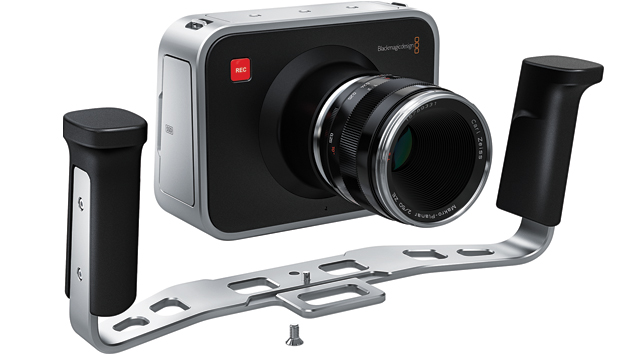Records to CinemaDNG, ProRes, and DNxHD with a 2.5K Micro 4/3 Sensor and 13 Stops of Dynamic Range
Once upon a time there was a small Australian company that made capture cards, I/O and monitoring devices, routers and converter boxes. But when Blackmagic Design purchased DaVinci three years ago and subsequently rolled out both a hardware-enhanced and software-only version of Resolve, the company made clear it was not afraid to jump into completely new product categories, upending expectations as it went.
It has since been in both acquisition (Teranex) and development mode (USB 3.0, Thunderbolt). And on Monday, Blackmagic took another Evel Knievel leap and introduced the Blackmagic Design Cinema Camera, a 2.5K/1080HD camcorder that records uncompressed RAW, ProRes and DNxHD and features a built-in SSD recorder. Didn't see that one coming, did you? Neither did we.
So how will Blackmagic navigate an already crowded camera market? It will start, as it did with Resolve, with the price. For the unbelievable $2,995, you get quite a lot, actually, starting with a super wide 13 stops of dynamic range and including that above-mentioned on-board solid state recorder, built-in Thunderbolt connectivity, 3 Gb/s SDI output, a copy of UltraScope for waveform monitoring, and a full copy of DaVinci Resolve (a $995 value right there). You also get a nifty touchscreen display, newsworthy in its own right, that combines the form factor of an external recorder with the ease of an iPhone or iPad. No more iPhones hanging off the back of cameras or fumbling for buttons. You start to see where this company is looking for inspiration but also for a roadmap.
Blackmagic has worked very closely with Apple for some time, evident in Blackmagic's streamlined designs and user interfaces, as well as the company's embrace of ProRes and Thunderbolt. And Apple sees this latest product announcement as added proof that the ProRes and Final Cut Pro ecosystem is more robust than ever. "All the metadata from this new camera will show up directly in FCPX," Apple's Richard Townhill told us on Sunday under NDA. "This camera, like the other devices announced during the show, will connect directly to FCPX. Metadata will be king."
But what about the images? The only early test footage out there is on Vimeo and comes from Australian cinematographer John Brawley, who continues to shoot internal engineering tests for Blackmagic. He shared some of the "home movies" he shot at Bondi Beach near Sydney with a Zacuto Rails setup, Arri FF and Mattebox. He's also got a detailed take on his experience with the camera thus far on his website. For a look at the actual footage, see the clips on this Vimeo PRO page he created here (sorry, no embeds, but it's best seen at full screen in the Vimeo PRO player). "It felt pretty good in my hands," says Brawley on his web site. "It was certainly solid and hefty. I wondered about it’s ergonomics, but in a way, it’s simple shape and elegance are it’s strength. It could easily be pimped up if you want extra handles, mounting brackets, shoulder rigs, etc."
It wasn't mentioned at Monday's press conference but Blackmagic told us later that the sensor is actually a Micro 4/3" (refrigerated for low noise), which makes perfect sense when you see the Cinema Camera's compact size. All the cameras in the booth were fully operational, save for the one under glass at the top corner of the company's massive booth. And they all had gorgeous Canon EF or Zeiss ZF lenses hanging off them.
As you'd expect with an interchangeable lens system and modular design, this new camera moves easily among its multiple personalities. Depending on the setup or your perspective, it can look like a DSLR-type camera, a studio camera—like the configuration shown above (there's also an optional sunvisor)—or a handheld camera that is balanced by another cleverly designed Blackmagic handle rig (top). Said Blackmagic's founder and GEO Grant Petty during the press conference, "We really think we've covered the three major personalities of what this camera can be in the way that it can be modified."
Blackmagic is positioning its new camera directly at high-end television commercials, episodic television and feature films. The company says that 2.5K and 1080HD capture are much more than just pixels in the punch and that the camera's full 13 stops of dynamic range will virtually eliminate the highlights and black clipping that come with similar resolutions. You have the option to shoot to edit and record in ProRes, or if you want more control in post, shoot RAW and later fire your new copy of Resolve that comes with the camera to further exploit them.
So what's the catch? I've spoken with many other attendees and manufacturers in the past few days here at the show and most are mystified at how Blackmagic pulled this off. Well, it's not exactly clear how they've done it, though it is clear that a very precise and elegant design and build process contributed to the singularity of the feature set, form factor and price.
Blackmagic has a lot more product news at this year's show. The company announced Monday that it has already rewritten the UI of the game-changing DaVinci Resolve and will release a new version in July, when the Cinema Camera is also scheduled to begin shipping.
Did you enjoy this article? Sign up to receive the StudioDaily Fix eletter containing the latest stories, including news, videos, interviews, reviews and more.













Leave a Reply